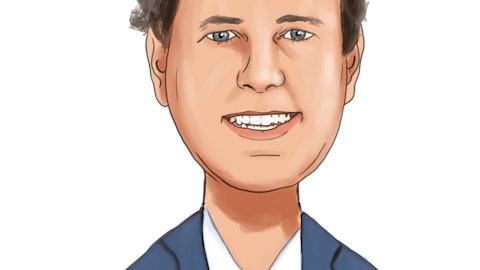Grupo Aval Acciones y Valores S.A. (NYSE:AVAL) Q3 2023 Earnings Call Transcript November 16, 2023
Operator: Welcome to Grupo Aval’s Third Quarter 2023 Consolidated Results Conference call. My name is Krista and I will be your operator for today’s call. Grupo Aval Acciones y Valores S.A., Grupo Aval, is an issuer of securities in Colombia and in the United States SEC. As such, it is subject to compliance with securities regulations in Colombia and applicable US securities regulation. Grupo Aval is also subject to the inspection and supervision of Superintendency of Finance as holding company of the Aval financial conglomerate. The consolidated financial information included in this document is presented in accordance with the IFRS as currently issued by the IASB. Details of the calculations of non-IFRS measures such as ROAA and ROAE, among others, are explained when required in this report.

A view of high-rises against an open sky, alluding to the commercial banking products & services offered by the company.
Banco de Bogota executed a spin-off of a 75% equity stake in BAC Holding’s International Corp, BHI, to its shareholders and Grupo Aval subsequently spin off its equity interest to its shareholders on March 29th, 2022. On December 19th, 2022, Banco de Bogota sold 20.89% of the outstanding investment of BHI through a tender offer. As of December 31st, 2022, Banco de Bogota held 4.11% of BHI. This investment is reflected as an investment at fair value through other comprehensive income. Following the sale, the equity method recognized under the share of profit of equity accounted investees, net of tax equity method between April and November was reclassified to discontinued operations. For comparability purposes of this presentation, we have reclassified BHI’s equity method for the second and third quarter of 2022 to net income from discontinued operations.
Banco de Bogota’s remaining 4.11% interest in BHI was disposed of in March 2023. The report includes forward looking statements. In some cases, you can identify these forward-looking statements by words such as may, will, should, expect, plans, anticipates, believes, estimates, predicts, potential or continue or the negative of these words and other comparable words. Actual results and events may differ materially from those anticipated herein as a consequence of change — changes in general, economic and business conditions, changes in interest and currency rates and other risk factors described from time to time in our filings with the Registro Nacional de Valores y Emisores and the SEC. Recipients of this documents are responsible to the assessment and use of the information provided herein.
Matters described in this presentation and our knowledge of them may change extensively and materially over time, but we expressly disclaim any obligation to review, update or correct the information provided in this report, including any forward-looking statements, and do not intend to provide any update for such material developments prior to our next earnings report. The content of this document and its figures included herein are intended to provide a summary of the subjects discussed rather than a comprehensive description. When applicable, in this document, we refer to billions as thousands of millions. At this time, all participants are in a listen only mode. Later, we will conduct a question-and-answer session. I will now turn the call over to Mr. Luis Carlos Sarmiento Gutierrez, Chief Executive Officer.
Mr. Luis Carlos Sarmiento Gutierrez, you may begin.
See also 13 Cheap Monthly Dividend Stocks to Buy and 20 Most Valuable Brazilian Companies Heading into 2024.
Q&A Session
Follow Grupo Aval Acciones Y Valores S.a. (NYSE:AVAL)
Follow Grupo Aval Acciones Y Valores S.a. (NYSE:AVAL)
Luis Carlos Sarmiento Gutierrez: Good morning and thank you all for joining our Third Quarter 2023 Conference Call. Before Diego provides a detailed look at our numbers, I will provide an overview of Colombia’s macro scenario, also an update on recent changes at the top of three of our four Colombian banks and I will finish with some highlights of our financial performance during this quarter and our view for 2024. Let’s start with a macroeconomic scenario. After central banks around the world hiked rates to contain inflation, it is the consensus that a maximum level of rates has been reached and therefore we should see easing in monetary policies during 2024. In fact, before Mr. Powell from the US Federal Reserve delivered his assessment of monetary policy in the US this past August, it was a market consensus that the US would be the first developed country to start a path of easing rates.
However, that changed after Mr. Powell cautioned against over optimism and instead declared that the Fed would proceed slowly to lower rates and that it wouldn’t do so until abundant evidence existed that inflation was contained and trending towards 2%. In any case, the growth prospects of the US economy have significantly improved. In Europe, business activity has remained stronger than expected despite higher interest rates and the conflict in Ukraine. On the other hand, the Chinese economy has delivered disappointing results. The International Monetary Fund anticipates a still sluggish performance of global economic growth with a projection of 2.9% in 2024, slightly down from the 3% expected for this year. This updated forecast incorporates a divergence in growth trajectories among developed and emerging economies around the world.
In Colombia, domestic demand continued to decelerate and house sales dropped sharply as the cost of debt rises and weighs heavily in a typical family’s monthly revenue. This has negatively impacted economic growth, which only amounted to an adjusted 0.4% in the second quarter and minus 0.3% in the third quarter. On the other hand, social services, basically subsidies geared to the elderly population, mitigated the softer consumption of goods. Additionally, while primary activities and services improved, the weakness of manufacturing and construction persisted. Agriculture has improved as El Nino has delayed its arrival, especially benefiting coffee crops and oil production has not dropped as much as it was first thought after the government’s drastic announcements.
Accordingly, we now anticipate GDP growth of approximately 1% in 2023 and 1.5% to 1.75% for 2024. Inflation fell less than expected in the third quarter, reaching 11% in the previous 12 months and consequently expectations for annual inflation during 2023 were revised upwards. Monthly inflation during October came in at 0.25% below market consensus of 0.36% and brought 12-month inflation to 10.48%. Inflation during the last two months of the year will heavily depend on prices of regulated goods especially gasoline prices, which are expected to increase COP600 per gallon in November, energy tariffs that are highly dependent on the arrival of the El Nino phenomenon, and tolls, which are expected to increase 13.25% before year end. With this in consideration, annual inflation will likely end 2023 in the 9.6% area.
We expect that inflation during 2024 will moderate down to 6%. Regarding interest rates, if the trend inflation persists, the central bank might cut interest rates by 25 basis points in its December meeting, bringing the repo rate to 13%. In line with inflation, we expect additional repo rate reductions of approximately 500 basis points during 2024, ending the year at approximately 8%. Employment data has lagged economic performance and this is evidenced by a favorable trend in the labor market, which continued during the third quarter. In fact, despite softer economic data, the latest unemployment rate released by [Downing] (ph) shows that in September unemployment decreased to 9.3%, improving from 10.7% observed a year before. However, October data indicates that new job creations are slowing down and that dimension lag is fading.
Consequently, we are anticipating an increase in the unemployment rate to 11% by year end 2023, holding at that same level during 2024. Obviously, if the economy grows less than expected, or, in our point of view, if Congress approves the proposed labor reform, unemployment will be exacerbated. Regarding the exchange rate, although surrounded by ample volatility, the Colombian peso has appreciated approximately 18% during the year. In fact, just this week, it dropped under COP4,000 per dollar. One of the primary drivers of a stronger Colombian peso, in addition to the global weakening of the dollar, appears to be the generalized perception that the most concerning aspects of the health, labor, pension fund and other reforms are less likely to be approved in Congress, particularly following the recent regional election results in which mostly members of opposition, political parties were elected governors, mayors and city council members.



